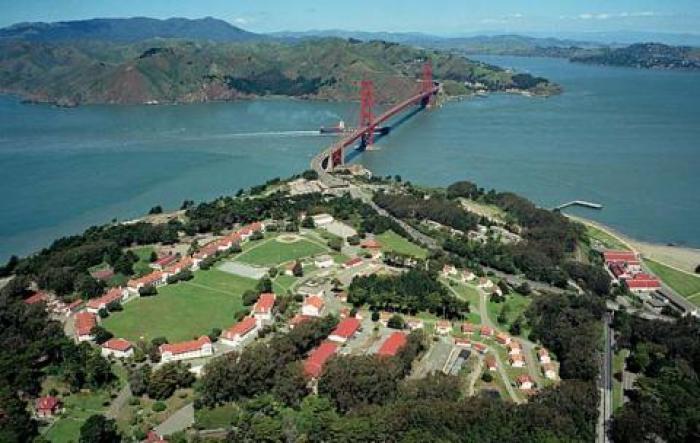Historical Sites of Presidio in San Francisco

Strategically located at the northern tip of San Francisco, California, the Presidio has played an important role in American History, taking in refuge way back from the Spanish Era, the Mexican-American War, and from World War II to the Civil War. Formerly known as El Presidio Real de San Francisco (or Royal Presidio of San Francisco), it was established as a Spanish Fort in 1776 to take control of the San Francisco Bay area and Lower California. It was transferred later to Mexico and in 1846 during the Mexican-American war, the U.S. Military took over, became an Army headquarters and transformed the barren ground into a green prime military post. The Presidio was involved in its first military commitment in the Asia/Pacific region being the assembly point who attacked the Philippines during the Spanish-American War. It became the center for defense during World War II, and remained active. It served as military base for the United States until 1994, when it was turned over to the National Park Service and became part of the Golden Gate National Recreation Area.
A park surrounded by hills, trees and perfect views of the Bay, Pacific Ocean and the Golden Gate Bridge, the Presidio became a National Historic Landmark in 1962 along with such places contributing to it:
- Crissy Field - named after the base commander of Mather Field, California, Maj. Dana H. Crissy died in crash during a test by the Air Service from the field of Presidio to Roosevelt, New York. Crissy Field was the first Air Coast Defense Station of the military to provide weapon defenses on the Pacific. It supported operations for liaison flights, archeological searches, aerial photography, forest fire patrol, search-and-rescue flights and U.S. Air Mail Service. It was also a runway for flights and landing of aviators who set their long-distance flying records. Local flights became difficult due to wind and fog, construction of the Golden Gate Bridge, and a very short runway for heavy aircraft, and susceptibility to attacks led to its closure in 1936. It became barracks and classrooms for a top secret facility of army where Japanese Americans were trained as interpreters. Currently, Crissy Field is open to the public and operates an environmental center conducting educational programs, exhibits, a media and science laboratory, resource library and arts workshop. The Presidio features West Bluff in the westernmost part for picnicking, walking trails to the Golden Gate Bridge and Fort Point, and refreshments at the Warming Hut café. Restoration of Crissy Field includes tidal wetlands for fishes and birds, tidal marsh for native flora and fauna, sand dunes for species habitat, and a vast grassy airfield which marks the cultural and historical importance during landing to slow down the airplanes.
- Fort Point - Fort Point was completed before the Civil War in the U.S. to defend the Bay of San Francisco from ship attack. The construction began during the peak of the Gold Rush in California, showing perfect works of masonry which hadn't experience any attack, so the structures remained sturdy up to this date. It became temporary housing and training schools for the military. Visiting the Fort, start inside the grand hall, climb the staircase and finally to the top viewing deck of the Golden Gate Bridge.
- Letterman Army Medical Center - was known as Letterman Army Hospital, after Major Jonathan Letterman, a founding father of military medicine who organized emergency units on the field and ambulance services. Established during the Spanish American War in 1898 for soldiers that became sick in the Presidio camps, it also admitted civilians of San Francisco who were injured in 1906 earthquake. It was the largest army general hospital in 1918, caring and treating soldiers with serious wounds and with psychiatric cases returning from World War I. Physicians of the hospital developed the “Letterman Leg” and introduced physical therapy. It became the major hospital in 1945 for treating sick and wounded soldiers during World War II. Transformed into a more modern hospital in 1969, the Letterman Army Medical Center treated wounded soldiers from Vietnam. Letterman Army Institute of Research was opened in 1971 for the development of artificial blood, laser physics and trauma treatment. It mostly served military retirees and their dependents by the late 1980’s. It was later shut down in 1995 after the Presidio was moved to the National Park Service.
- Letterman Digital Arts Center (LDAC) - though retaining the name, it was transformed from Letterman Hospital to a LucasArt and Industrial Light & Magic division of Lucasfilm in 2005, to continually preserve the San Francisco Presidio. The great meadow with historical landscape and the lobby of Building B are the only parts open to the public. They contain a gallery of props, costumes and memorabilia from the Star Wars movies of Lucasfilm and an infamous statue of Yoda on a fountain.
- The Main Post – not only the heart, but also the most historic district of Presidio, and known as the birthplace of San Francisco. It served as a Spanish military base, and as Mexican and U.S. army posts for more than a century. Most structures from then still exist today and are preserved for public enjoyment, such as:
- Presidio Fire Department – the first fire station on any U.S. Army post to have a permanent fire company with trained firefighters. It was established in 1917 under congressional mandate led by Senator Warren after his daughter, Mrs. Pershing, wife of General Pershing, and three of their children died from a fatal fire accident.
- Alameda – became the official gate to the Presidio where cannonballs used to lined the streets.
- Presidio Parade Ground – six acre wide opening used for military exercises, drills and ceremonies, and now serves as a parking area, and a site for honorary gatherings and commemorative celebrations.
- San Francisco National Cemetery - built high on west of the Main Post overlooking the bay, and expanded to almost 29 acres. Holds the final resting place of 30,000 soldiers, family members and important personalities including remains removed from camps and forts at Pacific coast and western frontier. Currently, they are no longer accepting interments except for eligible veterans or family members. It is open everyday to the public with guided tours to those who want to commemorate historical wars from the beginning of time.
- Pet Cemetery - animals also had their burial places which were owned by army families at the Presidio. Markers engraved on their stones are name, birthplace, family name with rank of the owner. Almost hidden behind temporary fencing, it is currently preserved as cultural landmark under construction of a bridge over it.
- World War II Memorial - a granite wall with name carvings of armed forces members located above the hill of Monterey pine and cypress overlooking the Pacific Ocean where hundreds of them lost or died on World War II. In front is a statue of Columbia by award-winning sculptor Jean de Marco made of the same material. Though the Memorial is a honorable memento of heroism, it is a bit not so popularly flocked by the public.
- Wave Organ at Inspiration Point - one of the many almost hidden treasures of San Francisco: visit during high tides even if it means to get up very early in the morning and follow the plaque instruction. When the old cemetery during the Gold Rush era was removed to built a housing community, they moved the stones to a little peninsula on the eastern side of the Golden Gate National Recreation Area. Large PVC pipes are planted into the granite blocks all the way down to the ocean creating the organ. Stick your head near one of these and listen to the mixed sounds of water, wind, ships, waves, birds, sea gulls creating a symphony of nature which is both exhilarating and relaxing.
(photo.credit.http://sf.funcheap.com/pedaling-presidio-free-guided-bike-tour-sf/)
Recent Hostel Blog

